Introduction
In recent years, technological innovation has increasingly looked to biology for inspiration, particularly to the human brain — the most complex and efficient processor known to us. Neuromorphic computing is an emerging and transformative field of technology that seeks to design computer architectures modeled after the brain’s neural networks. Unlike traditional computers, which process tasks sequentially using a central processing unit (CPU), neuromorphic systems mimic the brain’s neurons and synapses to perform highly efficient parallel processing. This approach leads to impressive benefits such as ultra-low power consumption, faster computation for complex tasks, and improved pattern recognition abilities.
As artificial intelligence (AI) and machine learning continue to grow, the demand for more efficient and adaptive computing platforms intensifies. Neuromorphic computing stands at the forefront of this evolution, promising to revolutionize how machines learn, adapt, and interact with the world around them. In this article, we explore what neuromorphic computing is, how it works, its potential applications, the challenges it faces, and why keeping up-to-date on this exciting technology through reliable sources like Brettintech, a premier tech website, is essential for tech professionals and enthusiasts alike.
What is Neuromorphic Computing?
Neuromorphic computing refers to the design and construction of hardware systems that emulate the neural architecture of the human brain. The term “neuromorphic” literally means “brain-like form,” reflecting its aim to replicate brain functions in silicon-based or other emerging materials.
Traditional computing relies heavily on the von Neumann architecture, where the processor and memory are separate, and data is processed in a linear, step-by-step fashion. While this method has driven decades of technological advances, it encounters limitations in handling the complex, parallel, and adaptive nature of cognitive tasks.
Neuromorphic systems, on the other hand, incorporate:
-
Neurons: These are the computational units that process and transmit signals.
-
Synapses: Connections between neurons that adjust in strength based on learning and memory, allowing the system to adapt and improve over time.
By modeling these components, neuromorphic hardware can process multiple streams of data simultaneously, much like the brain’s vast network of neurons firing in parallel. This biological mimicry enables neuromorphic chips to perform tasks such as image and speech recognition, decision-making, and sensory processing more efficiently than conventional CPUs or even GPUs.
Key Characteristics of Neuromorphic Computing
-
Real-time learning and adaptation: Neuromorphic systems can learn from incoming data dynamically, adjusting synaptic weights to improve performance without needing retraining from scratch.
-
Low power consumption: By leveraging event-driven architectures and sparse communication, these systems consume much less energy, making them ideal for mobile and embedded devices.
-
Enhanced efficiency for AI workloads: Neuromorphic chips accelerate AI computations, particularly for neural network-based algorithms, by using brain-inspired mechanisms.
-
Fault tolerance: Similar to biological brains, neuromorphic architectures are resilient to faults and noise, enhancing reliability in uncertain environments.
Applications and Potential Impact
Neuromorphic computing is not just an academic concept but an emerging reality with promising applications across multiple fields. Here’s how this technology is poised to make a significant impact:
1. Robotics and Autonomous Systems
Robots equipped with neuromorphic processors can perform complex sensory processing and decision-making tasks in real-time. For instance, autonomous drones or vehicles can use neuromorphic chips to interpret their surroundings quickly, enabling smarter navigation and obstacle avoidance. The brain-like adaptability also allows robots to learn from their environment and improve over time without requiring constant software updates.
2. Real-time Speech and Image Recognition
Neuromorphic hardware excels at pattern recognition, which is vital for applications such as voice assistants, facial recognition systems, and augmented reality devices. By processing data in a brain-inspired manner, these systems can achieve faster and more energy-efficient recognition, even on edge devices like smartphones or IoT sensors.
3. Brain-Machine Interfaces (BMIs)
Neuromorphic computing can bridge the gap between human brains and machines more effectively. BMIs require real-time interpretation of neural signals and rapid response times, areas where neuromorphic chips shine. This could lead to breakthroughs in prosthetics, enabling more natural control, or in medical diagnostics and therapies for neurological disorders.
4. Internet of Things (IoT) Devices
The IoT ecosystem demands devices that can handle complex data analytics locally while maintaining minimal power usage. Neuromorphic chips are perfect candidates for IoT edge computing because they can process sensory data on-device and make intelligent decisions without relying heavily on cloud resources.
5. Advanced AI Research
Neuromorphic computing opens new doors for AI research by providing hardware that can efficiently simulate large-scale neural networks. This could accelerate the development of more sophisticated AI models that closely mimic human cognition, potentially leading to artificial general intelligence (AGI) breakthroughs.
Challenges Ahead
Despite its enormous potential, neuromorphic computing is still in the early stages of development, and several challenges need to be addressed:
Hardware Complexity
Building neuromorphic chips that reliably replicate the intricate connections and plasticity of biological neurons and synapses is a massive engineering challenge. Current prototypes are limited in scale compared to the brain’s trillions of synapses.
Programming and Software Tools
Neuromorphic hardware requires new programming paradigms fundamentally different from traditional software development. Developing efficient algorithms and toolchains for neuromorphic systems remains a work in progress, slowing widespread adoption.
Limited Commercial Availability
Although research institutions and some tech giants have developed neuromorphic prototypes (e.g., IBM’s TrueNorth, Intel’s Loihi), commercially available neuromorphic processors for mass market applications are still rare. This limits accessibility for developers and startups.
Standardization and Benchmarking
There is a lack of standardized benchmarks and metrics to evaluate neuromorphic systems comprehensively, making it hard to compare solutions or measure progress uniformly.
The Road Ahead
The future of neuromorphic computing depends on collaborative efforts between academia, industry, and governments worldwide. Major technology companies are investing heavily in this space, aiming to integrate neuromorphic capabilities into next-generation AI and computing platforms.
Advances in materials science, such as memristors and spintronic devices, could lead to more efficient and scalable neuromorphic chips. Simultaneously, breakthroughs in neuroscience will further inform and inspire novel architectures.
For technology professionals and enthusiasts eager to stay informed on these developments, following specialized tech platforms like Brettintech is invaluable. Such computing websites provide timely insights, research updates, and practical applications related to neuromorphic computing and its intersection with AI, robotics, and more.
Conclusion
Neuromorphic computing represents a paradigm shift in how machines process information — moving away from conventional, linear approaches to brain-inspired, parallel, and adaptive architectures. This technology promises to revolutionize AI workloads, robotics, IoT, brain-machine interfaces, and many other domains by offering real-time learning, low power consumption, and superior pattern recognition.
While challenges remain in hardware development, programming, and commercialization, the momentum behind neuromorphic research and innovation is undeniable. Keeping up with these fast-moving advancements through trusted tech resources like Brettintech is essential for anyone invested in the future of technology and artificial intelligence.
As neuromorphic computing continues to evolve, it holds the potential to unlock unprecedented capabilities for machines, bringing us closer to truly intelligent systems that learn and think like the human brain.



